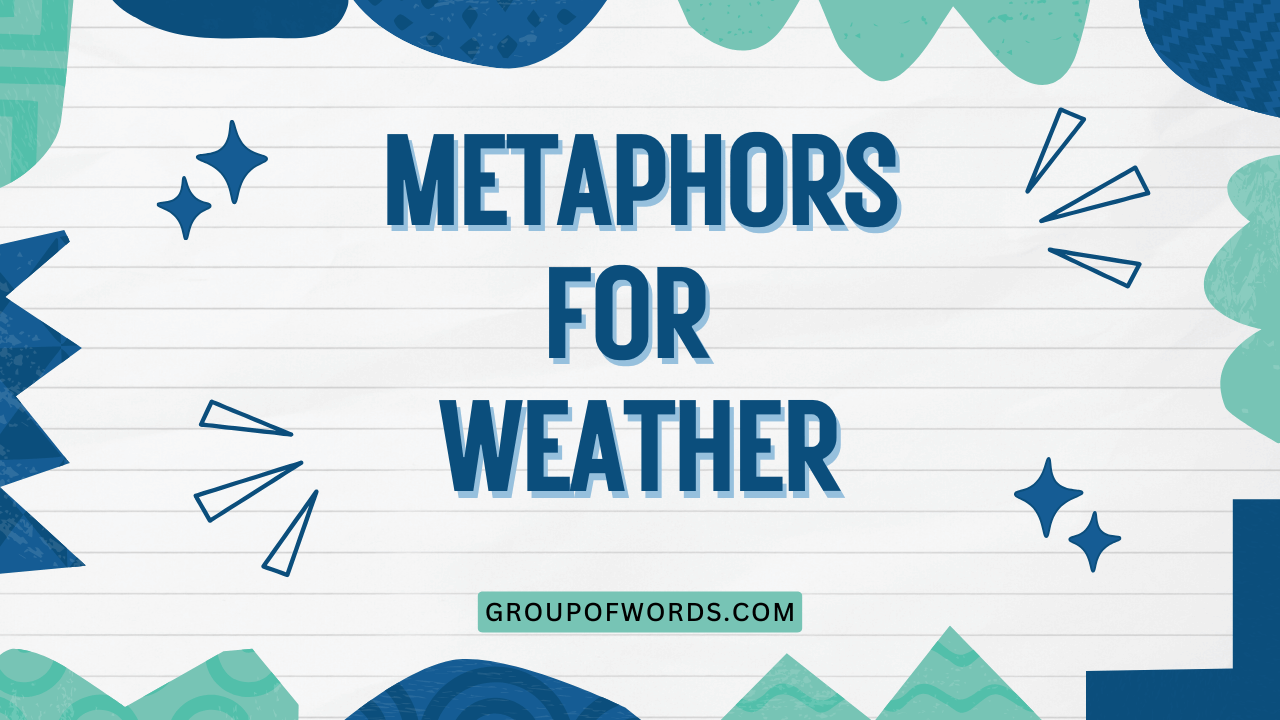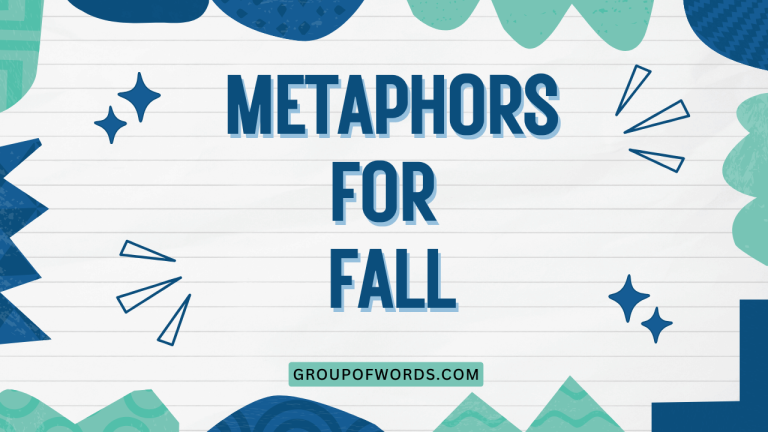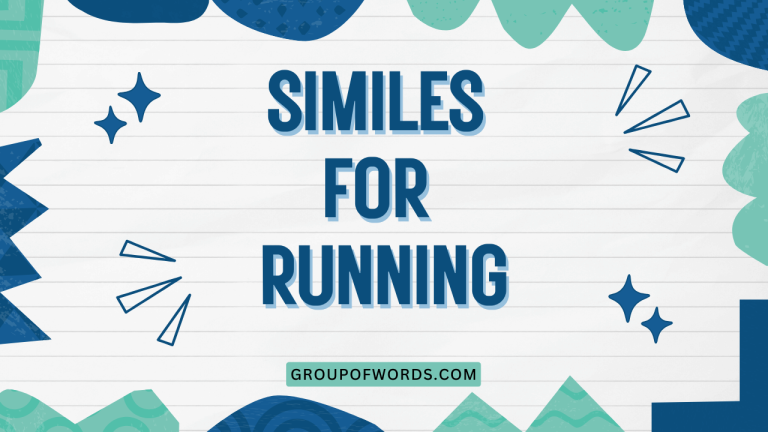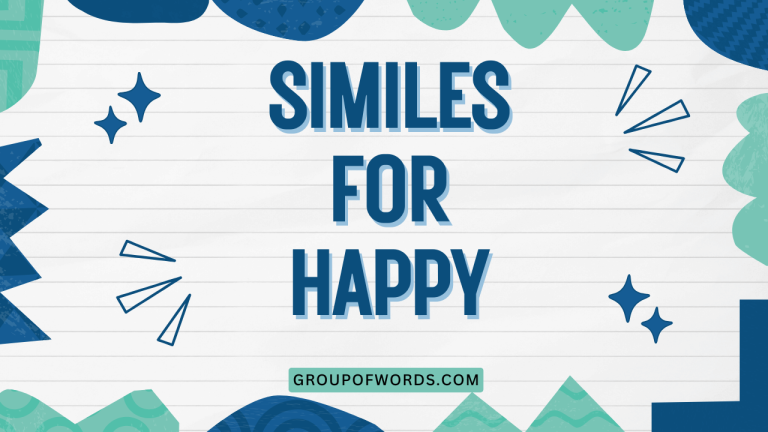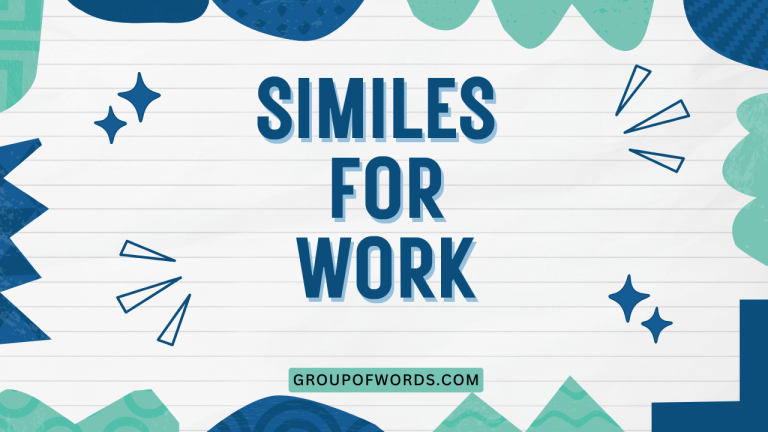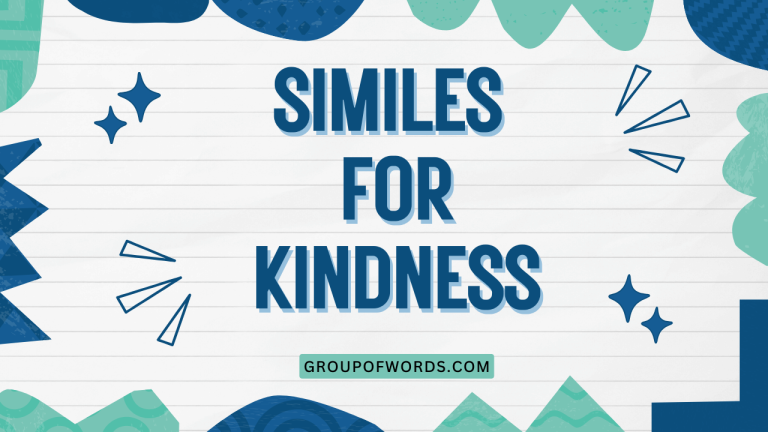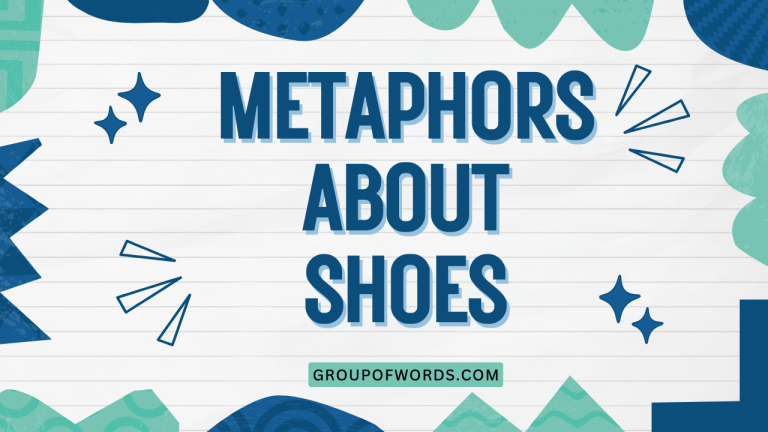Weather Metaphors: A Comprehensive Guide to Figurative Language
Understanding metaphors is crucial for mastering English, as they add depth and color to our language. Weather metaphors, in particular, are widely used to describe emotions, situations, and even people.
This article provides a comprehensive guide to weather metaphors, exploring their definitions, structures, types, and usage rules. Whether you’re an English language learner or a seasoned speaker, this guide will enhance your understanding and appreciation of figurative language.
This article will benefit students, educators, and anyone looking to enrich their communication skills. We’ll explore examples, common mistakes, and practice exercises to solidify your understanding.
By the end of this article, you’ll be able to identify, interpret, and use weather metaphors with confidence, adding nuance and creativity to your writing and speech. We will also discuss advanced applications of weather metaphors and address frequently asked questions to ensure a thorough understanding of the topic.
Table of Contents
- Definition of Weather Metaphors
- Structural Breakdown of Weather Metaphors
- Types of Weather Metaphors
- Examples of Weather Metaphors
- Usage Rules for Weather Metaphors
- Common Mistakes with Weather Metaphors
- Practice Exercises
- Exercise 1: Identifying Weather Metaphors
- Exercise 2: Using Weather Metaphors
- Exercise 3: Correcting Misused Metaphors
- Advanced Topics in Weather Metaphors
- Frequently Asked Questions (FAQ)
- Conclusion
Definition of Weather Metaphors
A metaphor is a figure of speech that directly compares two unrelated things by stating that one thing is another. It’s a powerful tool used to convey complex ideas or emotions in a vivid and relatable way. Weather metaphors specifically use elements of weather – such as sunshine, rain, storms, and fog – to describe non-weather related concepts like emotions, situations, or personal characteristics. The core function of a weather metaphor is to create a deeper understanding and emotional connection by drawing parallels between abstract ideas and tangible weather phenomena.
Weather metaphors enrich language by adding layers of meaning and allowing for more evocative descriptions. They are frequently used in literature, poetry, journalism, and everyday conversation.
The context in which a weather metaphor is used is crucial for its interpretation; understanding the underlying comparison is key to grasping the intended meaning.
Structural Breakdown of Weather Metaphors
Weather metaphors typically consist of two main elements: the tenor and the vehicle. The tenor is the subject being described, while the vehicle is the weather element used to describe it. The connection between the tenor and vehicle is often implicit, requiring the reader or listener to draw the comparison. Understanding this structure helps in both interpreting and creating effective weather metaphors.
For example, in the sentence “Her smile was a ray of sunshine,” the tenor is “her smile” and the vehicle is “a ray of sunshine.” The metaphor suggests that her smile is bright, warm, and uplifting, similar to the feeling of sunshine. The effectiveness of the metaphor lies in the reader’s ability to connect these two elements and understand the intended meaning.
Weather metaphors also rely on the emotional and cultural associations we have with different types of weather. For instance, storms are often associated with chaos or turmoil, while calm weather is associated with peace and tranquility.
Types of Weather Metaphors
Weather metaphors can be broadly categorized based on what they are used to describe. The three primary categories are emotional weather, situational weather, and character weather.
Each category uses weather elements to represent different aspects of human experience.
Emotional Weather
Emotional weather metaphors describe a person’s emotional state using weather-related terms. These metaphors are highly effective in conveying the intensity and nature of feelings.
They can range from subtle hints to dramatic pronouncements of inner turmoil or joy. These metaphors leverage our common understanding of how weather affects our mood to vividly depict emotional states.
Situational Weather
Situational weather metaphors describe a particular situation or event using weather imagery. These metaphors often relate to the atmosphere, intensity, or outcome of a situation.
These can describe anything from a business negotiation to a political climate, using weather to convey the dynamics at play. The weather metaphor allows for a quick and impactful understanding of the situation’s characteristics.
Character Weather
Character weather metaphors describe a person’s character or personality traits using weather-related terms. These metaphors provide insight into someone’s general disposition and behavior.
Using weather to describe character traits can create a lasting impression and offer a quick, easily understood description of someone’s personality. A person might be described as having a ‘sunny disposition’ or being ‘stormy’ in nature.
Examples of Weather Metaphors
The following sections provide extensive examples of weather metaphors categorized by their usage: emotional weather, situational weather, and character weather. Each example is designed to illustrate how weather elements can be used to describe different aspects of human experience.
Emotional Weather Examples
This table provides examples of how weather metaphors are used to describe various emotions. The examples are categorized to illustrate the range of emotions that can be conveyed using weather imagery.
| Emotion | Weather Metaphor | Explanation |
|---|---|---|
| Happiness | She was a ray of sunshine. | She brought joy and warmth to everyone around her. |
| Sadness | A cloud of gloom hung over him. | He was feeling deeply depressed and unhappy. |
| Anger | He was a brewing storm. | He was on the verge of exploding with anger. |
| Anxiety | She felt a fog of uncertainty. | She was confused and unsure about what to do. |
| Peace | Her mind was a calm sea. | She was feeling serene and at peace with herself. |
| Excitement | He was walking on cloud nine. | He was extremely happy and elated. |
| Fear | A chill wind of fear swept through him. | He was suddenly overcome with terror. |
| Hope | A glimmer of sunshine peeked through the clouds. | There was a small amount of hope in a difficult situation. |
| Despair | He was drowning in a sea of despair. | He felt completely hopeless and overwhelmed. |
| Relief | The storm had passed. | A difficult situation was finally over, bringing relief. |
| Love | Her love was a warm breeze on a summer day. | Her love was gentle, comforting, and pleasant. |
| Jealousy | A dark cloud of jealousy overshadowed their friendship. | Jealousy was negatively impacting their relationship. |
| Guilt | He was haunted by a storm of guilt. | He felt intense remorse and regret. |
| Confusion | She was lost in a blizzard of thoughts. | She was overwhelmed with conflicting ideas and couldn’t think clearly. |
| Frustration | He was weathering a frustrating drought of success. | He was experiencing a prolonged period without achieving his goals. |
| Contentment | They basked in the sunshine of their happiness. | They enjoyed the warmth and joy of their contentment. |
| Grief | A deluge of grief washed over her. | She was overwhelmed by intense sorrow and mourning. |
| Longing | His heart was parched in the desert of her absence. | He deeply missed her and felt empty without her. |
| Resentment | A bitter frost of resentment settled between them. | Resentment had created a cold and unfriendly atmosphere in their relationship. |
| Serenity | Her spirit was as still as a windless sky. | She felt a deep sense of peace and tranquility. |
| Impatience | He felt a thunderstorm of impatience brewing inside him. | He was becoming increasingly agitated and restless. |
| Disappointment | The news fell like a cold rain on his parade. | The news dampened his enthusiasm and joy. |
| Awe | She stood in silent awe, like a tree under a lightning storm. | She was overwhelmed by something powerful and majestic. |
| Embarrassment | He felt a scorching heatwave of embarrassment flood his face. | He was intensely ashamed and uncomfortable. |
| Nostalgia | Memories drifted back like a gentle snowfall. | She was fondly recalling past events, with a sense of peace and beauty. |
Situational Weather Examples
This table illustrates how weather metaphors can be used to describe different situations and events. The metaphors help convey the atmosphere, intensity, and potential outcomes of various scenarios.
| Situation | Weather Metaphor | Explanation |
|---|---|---|
| Economic Crisis | The economy is weathering a storm. | The economy is facing a difficult and turbulent period. |
| Political Tension | A political storm is brewing. | There is increasing tension and conflict in the political arena. |
| Business Opportunity | A window of opportunity opened like a break in the clouds. | A favorable chance appeared suddenly. |
| Project Success | The project sailed through on a fair wind. | The project progressed smoothly and successfully. |
| Relationship Conflict | Their relationship is going through a rough patch. | The relationship is experiencing difficulties and challenges. |
| Market Boom | The market is experiencing a sunny spell. | The market is performing well and growing. |
| Technological Advancement | A wave of innovation is sweeping the industry. | New technologies are rapidly transforming the industry. |
| Social Unrest | A storm of protests erupted in the city. | Widespread demonstrations and unrest occurred. |
| Creative Block | He was stuck in a creative drought. | He was unable to generate new ideas or inspiration. |
| Unexpected Good Fortune | She was blessed with a windfall of good luck. | She unexpectedly received a large amount of good fortune. |
| Academic Pressure | The pressure of exams felt like a relentless downpour. | The constant stress and demands of exams were overwhelming. |
| Business Competition | The business landscape was a cutthroat blizzard. | The intense competition made it difficult to succeed. |
| Social Change | A gentle tide of progress was reshaping society. | Slow but steady changes were transforming social norms and values. |
| Legal Battle | The legal battle turned into a drawn-out squall. | The legal proceedings became prolonged and unpleasant. |
| Artistic Inspiration | Inspiration struck like a sudden lightning bolt. | A brilliant idea appeared unexpectedly and powerfully. |
| Job Market | The job market was a frozen wasteland. | There were very few job opportunities available. |
| Environmental Crisis | The planet is facing a climate storm. | The world is dealing with severe environmental challenges. |
| Scientific Discovery | A breakthrough emerged like a clear sky after a long storm. | A significant discovery was made after a period of difficulty. |
| Political Reform | A whirlwind of reform swept through the government. | Radical changes were rapidly implemented in the government. |
| Cultural Shift | A cultural thaw began to melt old traditions. | Traditional customs were gradually being replaced by new values. |
| Personal Transformation | He emerged from his struggles like a rainbow after the rain. | He became stronger and more resilient after overcoming challenges. |
| Educational Reform | The educational system needed a fresh breeze of change. | The education system required innovative updates and improvements. |
| Community Recovery | The community rebuilt itself after the disaster, like grass after a fire. | The community regained strength and vitality after a devastating event. |
| Global Pandemic | The world was engulfed in a pandemic storm. | The pandemic caused widespread disruption and hardship worldwide. |
| Economic Recovery | The economy slowly emerged from the recession, like a plant emerging from winter. | The economy gradually recovered from a period of decline. |
Character Weather Examples
This table provides examples of how weather metaphors can be used to describe a person’s character or personality traits. These metaphors offer a vivid and concise way to convey someone’s general disposition.
| Character Trait | Weather Metaphor | Explanation |
|---|---|---|
| Cheerful | She has a sunny disposition. | She is generally happy and optimistic. |
| Gloomy | He’s a bit of a wet blanket. | He tends to dampen the mood and bring others down. |
| Temperamental | She’s a bit stormy sometimes. | She can be unpredictable and prone to outbursts. |
| Calm | He’s as calm as a summer breeze. | He is very relaxed and peaceful. |
| Unpredictable | She’s like a changeable sky. | Her moods and behavior are erratic and unpredictable. |
| Gentle | He has a gentle warmth about him. | He is kind and compassionate. |
| Cold | She has an icy demeanor. | She is unfriendly and aloof. |
| Bright | He’s a bright spark. | He is intelligent and quick-witted. |
| Stubborn | He’s as immovable as a mountain in a storm. | He is resistant to change and difficult to persuade. |
| Reliable | She’s a steady rain. | She is consistent and dependable. |
| Outgoing | He’s a whirlwind of energy. | He is energetic, enthusiastic, and sociable. |
| Reserved | She keeps herself under a cloud. | She is shy and prefers to stay in the background. |
| Passionate | He’s a fiery soul. | He is intensely passionate and enthusiastic. |
| Tough | She’s weathered many storms. | She has faced many challenges and become resilient. |
| Optimistic | He always sees the silver lining in every cloud. | He always finds something positive in difficult situations. |
| Pessimistic | She always expects a rainy day. | She tends to anticipate negative outcomes. |
| Wise | He’s like an old oak that has seen many seasons. | He possesses wisdom gained from long experience. |
| Naive | She’s as innocent as a spring rain. | She is pure, unspoiled, and easily trusting. |
| Resilient | He bounces back like grass after a hailstorm. | He quickly recovers from setbacks and difficulties. |
| Adaptable | She changes with the seasons. | She easily adjusts to new situations and environments. |
| Inspiring | He is a beacon of light in a dark world. | He offers hope and guidance to others. |
| Supportive | She is a sheltering tree in a storm. | She provides comfort and protection during difficult times. |
| Authoritative | He commands the room like a thunderclap. | His presence is powerful and commanding. |
| Mysterious | She is as enigmatic as a fog-shrouded forest. | Her true nature is hidden and difficult to understand. |
| Vulnerable | He is as fragile as a snowflake. | He is easily hurt or damaged. |
Usage Rules for Weather Metaphors
Using weather metaphors effectively requires understanding some basic rules. First, ensure the metaphor is relevant and appropriate to the context. Overusing metaphors can diminish their impact, so use them judiciously. Also, be mindful of cultural associations with weather; different cultures may interpret weather symbols differently.
Consistency is also important. Avoid mixing metaphors from different domains, as this can create confusion. For example, don’t combine a weather metaphor with a sports metaphor in the same sentence unless it’s done intentionally for humorous effect. Finally, clarity is key. The metaphor should enhance understanding, not obscure it. If the metaphor is too abstract or convoluted, it may fail to communicate the intended meaning effectively.
Common Mistakes with Weather Metaphors
One common mistake is using clichéd weather metaphors, such as “raining cats and dogs.” While these metaphors are widely understood, they lack originality and can make your writing sound uninspired. Instead, try to create fresh and unique metaphors that capture the reader’s attention. Another common error is misunderstanding the connotations of weather terms. For example, using “sunny” to describe a situation that is actually chaotic or unpredictable would be inappropriate.
Another frequent mistake is mixing metaphors inappropriately. For instance, saying “He weathered the storm and then hit a brick wall” combines a weather metaphor with a construction metaphor, which can be jarring and confusing. Instead, maintain consistency within your metaphorical language. Finally, be careful not to use metaphors that are culturally insensitive or that could be misinterpreted in different contexts. Consider your audience and the potential impact of your words.
| Incorrect | Correct | Explanation |
|---|---|---|
| The project was a sunny storm. | The project was a turbulent storm. | “Sunny” and “storm” are contradictory. |
| He was raining cats and dogs of anger. | He was a brewing storm of anger. | “Raining cats and dogs” is a cliché. |
| Her love was a hurricane of gentle breezes. | Her love was a gentle breeze. | “Hurricane” and “gentle breezes” are contradictory. |
| The economy is a rollercoaster in a thunderstorm. | The economy is weathering a thunderstorm. | Avoid mixing unrelated metaphors. |
| His words were a flood of sunshine. | His words were a ray of sunshine. | “Flood” implies an overwhelming negative. |
Practice Exercises
These exercises will help you practice identifying, using, and correcting weather metaphors. Work through each exercise carefully, paying attention to the context and the intended meaning of the metaphors.
Exercise 1: Identifying Weather Metaphors
Identify the weather metaphor in each sentence and explain its meaning.
| Question | Answer |
|---|---|
| 1. She brought a ray of sunshine into the office. | Metaphor: ray of sunshine; Meaning: She brought happiness and positivity. |
| 2. The political climate is stormy. | Metaphor: stormy; Meaning: The political situation is tense and turbulent. |
| 3. He’s weathering a difficult period in his life. | Metaphor: weathering; Meaning: He is enduring and overcoming a challenging time. |
| 4. The news hit him like a cold front. | Metaphor: cold front; Meaning: The news was shocking and unpleasant. |
| 5. Their relationship is going through a dry spell. | Metaphor: dry spell; Meaning: Their relationship is lacking intimacy and excitement. |
| 6. He felt a fog of confusion surrounding the issue. | Metaphor: fog; Meaning: He was feeling uncertain and unclear about the issue. |
| 7. The project sailed through on a fair wind. | Metaphor: fair wind; Meaning: The project progressed smoothly and successfully. |
| 8. She was a whirlwind of energy at the event. | Metaphor: whirlwind; Meaning: She was incredibly active and enthusiastic. |
| 9. The economic recovery is a slow thaw. | Metaphor: thaw; Meaning: The economic recovery is gradual and progressive. |
| 10. His anger was a brewing storm. | Metaphor: brewing storm; Meaning: He was on the verge of exploding with anger. |
Exercise 2: Using Weather Metaphors
Complete each sentence using an appropriate weather metaphor.
| Question | Answer |
|---|---|
| 1. After the argument, a _______ settled between them. | frost |
| 2. The company is _______ the economic downturn. | weathering |
| 3. Her smile was like a _______ on a cloudy day. | ray of sunshine |
| 4. He felt a _______ of fear when he heard the news. | chill wind |
| 5. The project was delayed due to a _______ of setbacks. | storm |
| 6. A _______ of innovation is sweeping the industry. | wave |
| 7. She emerged from the crisis like a _______ after the rain. | rainbow |
| 8. His temper is like a _______. | thunderstorm |
| 9. The negotiation process was a _______. | long, drawn-out squall |
| 10. The job market is a _______ for recent graduates. | frozen wasteland |
Exercise 3: Correcting Misused Metaphors
Identify and correct the misused weather metaphor in each sentence.
| Question | Corrected Answer |
|---|---|
| 1. The sunny storm raged through the town. | The violent storm raged through the town. |
| 2. He was a gentle hurricane. | He was a powerful force. |
| 3. The economy is a rollercoaster in a drought. | The economy is experiencing a severe drought. |
| 4. Her anger was a calm volcano. | Her anger was a dormant volcano. |
| 5. The project was a flood of sunshine and rainbows. | The project was a ray of sunshine and rainbows. |
| 6. He approached the task with a blizzard of tranquility. | He approached the task with a calm focus. |
| 7. She was as quiet as a thunderclap. | She was as quiet as a gentle breeze. |
| 8. Their relationship was a drought of passion and intimacy. | Their relationship was experiencing a drought of passion and intimacy. |
| 9. He’s as steady as a changeable sky. | He’s as steady as a clear sky. |
| 10. The news was a warm chill down her spine. | The news was a cold chill down her spine. |
Advanced Topics in Weather Metaphors
At a more advanced level, weather metaphors can be explored in the context of symbolism and archetypes. In literature, certain weather elements are often associated with specific themes or ideas. For example, rain might symbolize cleansing or renewal, while storms might represent conflict or transformation. Understanding these deeper symbolic meanings can enhance your interpretation of literary texts.
Additionally, weather metaphors can be used to create extended metaphors, where a single weather element is used consistently throughout a piece of writing to develop a complex and nuanced idea. This requires careful planning and execution, but it can be a powerful way to create a cohesive and impactful message. For instance, a writer might use the metaphor of a long winter to describe a period of hardship and then use the metaphor of spring to represent a time of renewal and hope. Consider the cultural and historical context when interpreting weather metaphors, as their meanings can vary across different traditions and time periods. The study of weather metaphors can also be approached through the lens of cognitive linguistics, which examines how our physical experiences shape our understanding of abstract concepts.
Frequently Asked Questions (FAQ)
Here are some frequently asked questions about weather metaphors:
-
What is the difference between a metaphor and a simile?
A metaphor directly equates two things, while a simile uses “like” or “as” to make a comparison. For example, “Her smile was sunshine” is a metaphor, while “Her smile was like sunshine” is a simile.
-
How can I create original weather metaphors?
Think about the specific qualities you want to convey and then brainstorm weather elements that share those qualities. Consider less common weather phenomena, such as auroras or monsoons, to add uniqueness.
-
Are weather metaphors universal?
While some weather metaphors are widely understood, others may be culturally specific. Be mindful of your audience and consider whether your metaphors will resonate with them.
-
Can I use weather metaphors in formal writing?
Yes, but use them sparingly and appropriately. Ensure that the metaphors enhance your message and do not detract from the overall tone and clarity of your writing.
-
How do I avoid clichés when using weather metaphors?
Be creative and avoid overused phrases like “raining cats and dogs.” Try to find fresh and unexpected ways to describe things using weather imagery.
-
What is the role of context in interpreting weather metaphors?
Context is crucial for understanding the intended meaning of weather metaphors. Consider the surrounding words, the overall tone of the writing, and the cultural background of the audience.
-
How can I improve my understanding of weather metaphors in literature?
Pay attention to the weather imagery used by authors and consider how it contributes to the themes and mood of the story. Research the symbolic meanings of different weather elements.
-
Why are weather metaphors so commonly used in language?
Weather metaphors are common because weather is a universal human experience. Everyone has experienced sunshine, rain, storms, and other weather phenomena, making these metaphors easily relatable and understandable.
-
Can weather metaphors be used to describe abstract concepts beyond emotions and situations?
Yes, weather metaphors can be used to describe various abstract concepts, such as the state of a project, the progress of a relationship, or the evolution of an idea. The key is to find a weather element that shares qualities with the abstract concept you want to describe.
-
Are there any specific types of writing where weather metaphors are more effective than others?
Weather metaphors are particularly effective in creative writing, poetry, and descriptive prose, where the goal is to evoke emotions and create vivid imagery. They can also be useful in journalism and persuasive writing to make complex ideas more relatable.
Conclusion
Weather metaphors are a powerful tool for enriching our language and conveying complex ideas and emotions in vivid and relatable ways. By understanding the structure, types, and usage rules of weather metaphors, you can enhance your ability to interpret and create effective figurative language.
Avoid common mistakes, such as clichés and mixed metaphors, and be mindful of cultural associations to ensure clarity and impact. Practice identifying, using, and correcting weather metaphors to solidify your understanding.
As you continue to explore the world of weather metaphors, remember to be creative and experiment with different combinations of weather elements and concepts. Pay attention to how weather metaphors are used in literature, journalism, and everyday conversation to expand your repertoire and refine your skills.
With practice and attention, you can master the art of using weather metaphors to add depth, color, and nuance to your communication.
